Chapter 25, Lesson 2: The Mouth through Esophagus
1/42
Earn XP
Description and Tags
Flashcards from Chapter 25, Lesson 2 of McGraw Hill Anatomy and Physiology, Tenth Edition, by Kenneth S. Saladin.
Name | Mastery | Learn | Test | Matching | Spaced |
|---|
No study sessions yet.
43 Terms

Oral cavity (buccal cavity)
The mouth
functions in ingestion, taste, digestion, swallowing, speech, and respiration
keratinized in areas subject to food abrasion, like the gums and hard palate
Cheeks and lips
Functions in food retention and oral control, speech, and sucking and blowing actions — closes exposure to outside
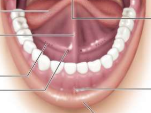
Frenulum
A type of tissue that attaches to the parts of the mouth; have superior and inferior labial (lip) types as well as one for the tongue (lingual)
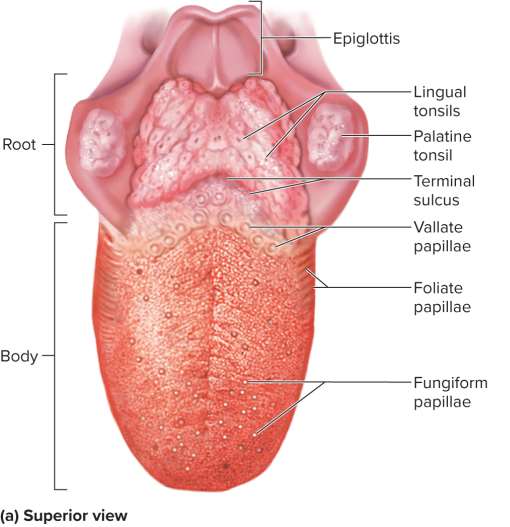
Tongue
A muscular, bulky, but agile and sensitive organ that functions in taste, texture, and speech with non-keratinized squamous epithelium
Lingual papillae
Bumps and projections that are the sites of most taste buds
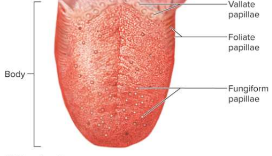
Body (of the tongue)
The anterior \frac{2}{3} of the tongue that occupies the oral cavity
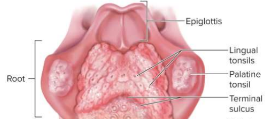
Root (of the tongue)
The posterior \frac{1}{3} of the tongue that occupies the oropharynx

Lingual tonsils
Tonsils contained in the root of the tongue; inflammation causes pain swallowing
Palate
Section of the mouth that separates the oral cavity from the nasal cavity, allowing breathing while chewing
Hard palate (bony palate)
Anterior portion of the palate supported by the maxillae and palatine bones
Soft palate
Posterior portion of the palate with a more spongy texture; features the skeletal muscle and glandular tissue as well as the uvula

Uvula
Projection visible at the rear of the mouth that helps food retention until ready to swallow
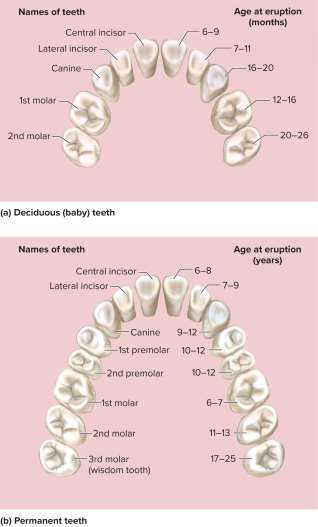
Dentitions
The teeth; they chew food into smaller pieces and expose more surface area for digestive enzyme action — 16 in the maxilla, 16 in the mandible for adults
Alveolus
The tooth socket in the bone where teeth are embedded
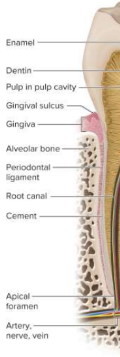
Periodontal ligament
Ligament whose collagen fibers penetrate into the bone on one side and into the tooth on the other for firm but slightly loose movement for chewing

Gingiva (gum)
Tissue that covers the alveolar bone for tooth embedding; teeth defined by gingiva portions of crown, root, and neck

Crown
The portion of the tooth above the gum
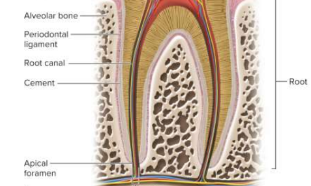
Root
The portion of the tooth below the gum in the alveolar bone
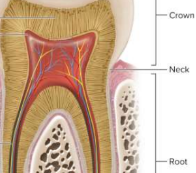
Neck
Point where the crown, root, and gum meet

Dentin
The hard yellowish tissue that makes up most of the tooth

Enamel
Noncellular secretion that cannot regenerate and covers the crown and neck of the tooth

Cement
Covers the root of the tooth
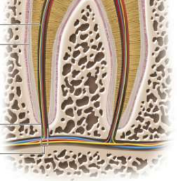
Root canal
The space in the root of the tooth leading to the pulp cavity in the crown; contains nerves and blood vessels
Eruption
The movement of teeth out of the gums as the develop; seen twice with infants and later permanent tooth replacement
Deciduous teeth
Early teeth that erupt from 6 to 30 months
Permanent teeth
Teeth that replace deciduous teeth between the ages of 6 and 25
Third molars (wisdom teeth)
Teeth that may erupt from 17 to 25 years, if at all — may be impacted or crowded so they cannot erupt
Plaque
A sticky residue on teeth made of bacteria and sugars due to the high count of microorganisms in the mouth — can dissolve enamel and dentin to form cavities
Root canal therapy
Treatment for cavities to remove the tooth to prevent further bacterial invasion
Mastication (chewing)
Process that breaks food down into smaller pieces to be swallowed and exposes more surface to digestive enzymes — starts with teeth and saliva
Saliva
Functions to moisten the mouth, begin some digestion, cleanse the teeth, inhibit bacterial growth, and dissolves food to stimulate taste buds
Salivary glands
Glands that secrete saliva at a constant rate
Pharynx
Muscular funnel that connects the oral cavity to the esophagus and nasal cavity to the larynx
Esophagus
The straight muscular tube 25 to 30 cm long between the pharynx and stomach to move food with some mucus
Lower esophageal sphincter (LES)
Sphincter at the inferior end of the esophagus to prevent stomach acid regurgitation that can damage the esophageal mucosa
Heartburn
Burning sensation produced by acid reflux into the esophagus
Deglutition (swallowing)
A complex action involving over 22 muscles in the mouth, pharynx, and esophagus to move food
Swallowing center
A pair of nuclei in the medulla oblongata that controls swallowing
Swallowing phases
Oral phase (voluntary to collect food)
Pharyngeal phase (involuntary to prevent choking)
Esophageal phase (involuntary to move food down)

Oral phase
Voluntary swallowing phase; collects food with tongue to push it posteriorly as it accumulates
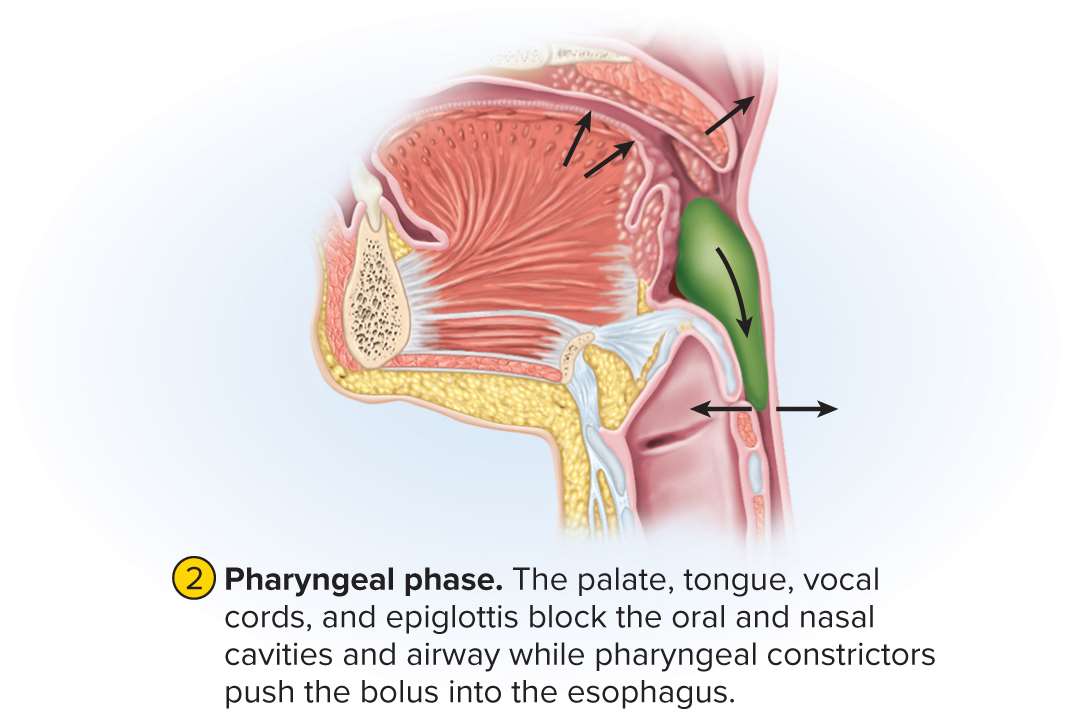
Pharyngeal phase
Involuntary swallowing phase; prevents food and drink from entering the mouth or nasal cavity and breathing is suspended as the airway is closed
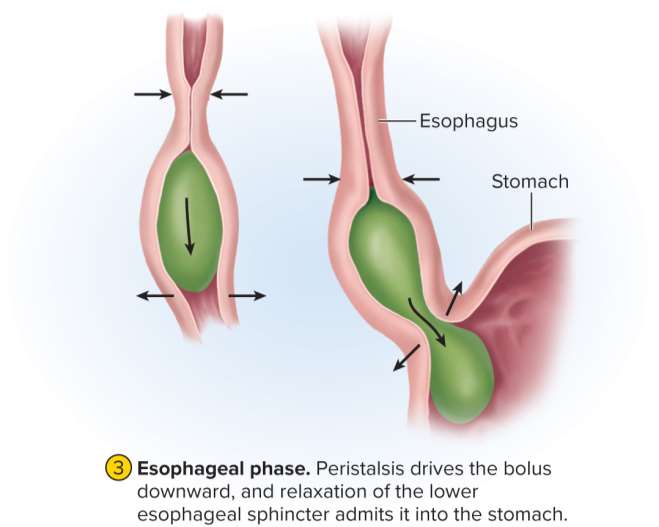
Esophageal phase
Involuntary swallowing phase with involuntary contractions (peristalsis) to move food through esophagus regardless of gravitational orientation
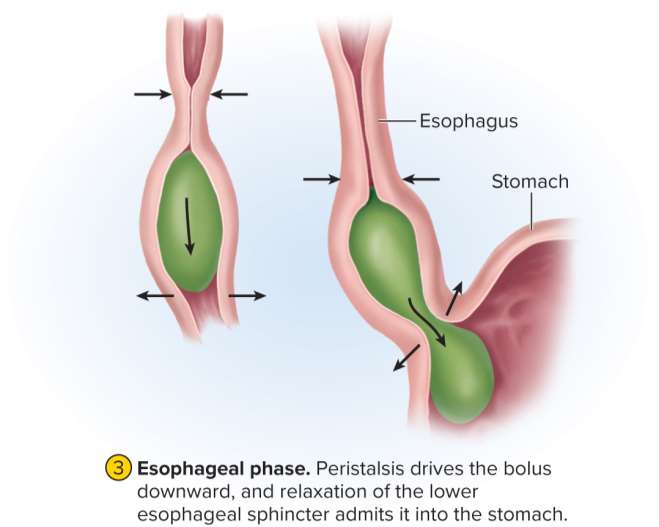
Peristalsis
Involuntary contractions that move food down the esophagus; is controlled by the swallowing center and leads the lower esophageal sphincter to relax